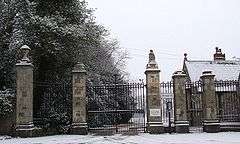Wrotham Park Estate Co Ltd v Parkside Homes Ltd
| Wrotham Park Estate Co Ltd v Parkside Homes Ltd | |
|---|---|
 | |
| Court | High Court of Justice, Chancery Division |
| Decided | 19 October 1973 |
| Citation(s) | [1974] 1 WLR 798 |
| Court membership | |
| Judge(s) sitting | Brightman J |
| Keywords | |
| Restitutionary damages | |
Wrotham Park Estate Co Ltd v Parkside Homes Ltd [1974] 1 WLR 798 is an English land law and English contract law case, concerning the measure and availability of damages for breach of negative covenant in circumstances where the court has refused specific relief. Such remedy is known as Wrotham Park damages, which are awarded (in lieu of specific performance or an injunction) under the jurisdiction created by s. 2 of the Chancery Amendment Act 1858 (also known as Lord Cairns' Act).
Facts
Wrotham Park was an estate that used to be owned by the Earl of Strafford. Over the years, portions of the land were sold off for development, subject to some lay-out restrictions. The Potters Bar Urban District Council came into the possession of one desolate triangle of land. They offered it for sale by public auction as freehold building land for 13 houses. Parkside bought the land and built the houses, despite warnings from Wrotham Park Estate that they were violating the lay-out restrictions. When the houses were built, Wrotham Park Estate brought a claim against Parkside for breach of the restrictive covenant.
Judgment
Brightman J (as he then was) awarded damages of £2,500 as a substitute for an injunction. The damages were measured as the amount that might reasonably have been demanded by the plaintiff as payment for relaxing the covenant, being 5% of the developer’s anticipated profit. He refused to make an order to demolish the houses built, preferring to award damages under Lord Cairns' Act, saying:
| “ |
... the defendants argue that the damages are nil or purely nominal, because the value of the Wrotham Park Estate as the plaintiffs concede is not diminished by one farthing in consequence of the construction of a road and the erection of 14 houses on the allotment site. If, therefore, the defendants submit, I refuse an injunction I ought to award no damages in lieu. That would seem, on the face of it, a result of questionable fairness on the facts of this case.... If, for social and economic reasons, the court does not see fit in the exercise of its discretion, to order demolition of the 14 houses, is it just that the plaintiffs should receive no compensation and that the defendants should be left in undisturbed possession of the fruits of their wrongdoing? Common sense would seem to demand a negative answer to this question.... In the present case I am faced with the problem what damages ought to be awarded to the plaintiffs in the place of mandatory injunctions which would have restored the plaintiffs’ rights. If the plaintiffs are merely given a nominal sum, or no sum, in substitution for injunctions, it seems to me that justice will manifestly not have been done.[1] |
” |
Impact
The jurisdiction for Wrotham Park damages has been expanded and clarified in subsequent cases, and was summarized by the Judicial Committee of the Privy Council in 2009:[2]
- Damages awarded are intended to compensate the claimant for the court's decision not to grant relief in the form of an order for specific performance or an injunction.
- The court will award an amount of damages which represents the sum that the claimant might reasonably have demanded from the defendant as compensation for allowing it to breach the relevant contractual provision. The court assesses this by reference to a "hypothetical negotiation" carried out between the parties at the date of breach.
- At the "hypothetical negotiation" both parties are assumed to act reasonably and the fact that the parties would never have reached a deal in reality is irrelevant.
- Although these damages are awarded in place of relief e.g. an injunction, it is not a prerequisite to their being awarded that either (i) the claimant applied for the injunction in the case or (ii) there was any prospect of such application succeeding.
While founded in land law, Wrotham Park damages have been found to be available in other contexts, such as employment law in the matter of restrictive covenants.[3]
However, there are limitations as to its applicability. It will not be available where a plaintiff has originally sought damages for consequential economic damages.[4]
See also
Further reading
- Burrows, Andrew (2008). "Are 'Damages on the Wrotham Park Basis' Compensatory, Restitutionary, or Neither?". In Saidov, Djakhongir; Cunnington, Ralph. Current Themes in the Law of Contract Damages. Oxford: Hart Publishing. pp. 165–185. ISBN 978-1-84113741-4. SSRN 2280322
 .
.
References
- ↑ "Wrotham Park Estate Ltd -v- Parkside Homes Ltd; ChD 1974". swarb.co.uk.
- ↑ Pell Frischmann Engineering Ltd v Bow Valley Iran Ltd & Ors [2009] UKPC 45, [2011] 1 WLR 2370 (26 November 2009), P.C. (on appeal from Jersey), par. 46–54; discussed at "Damages in Lieu of Injunction: Privy Council guidance on 'Wrotham Park damages'". Allen & Overy. 15 April 2010.
- ↑ One Step (Support) Ltd v Morris-Garner & Anor [2014] EWHC 2213 (QB) (7 July 2014), discussed in Simon Devonshire (15 July 2014). "Wrotham Park damages for breach of restrictive covenants and illegitimate competition? The Court says yes in One Step (Support) Ltd –v- Morris-Gardner & Anor [2014] EWHC 2213". 11 King’s Bench Walk.
- ↑ Arroyo & Ors v Equion Energia Ltd [2013] EWHC 3150 (TCC) (18 October 2013), discussed in Noel Dilworth (October 2013). "The limits of Wrotham Park damages" (PDF). Henderson Chambers.